Introduction
The first time I witnessed SawStop’s flesh-sensing technology in action, I was convinced it was a magic trick. A colleague deliberately pushed a hot dog into the spinning blade—and instead of slicing through, the blade stopped in less than 5 milliseconds with barely a scratch on the hot dog. The physics seemed impossible, yet there it was: technology that could prevent the most catastrophic workshop accidents.
But here’s the question that stopped me from immediately buying one: Is the SawStop jobsite table saw worth paying literally double what comparable saws cost? After six months of intensive testing, dozens of projects ranging from framing lumber to fine furniture, and countless conversations with other woodworkers who’ve made the investment, I can finally answer that question with confidence.
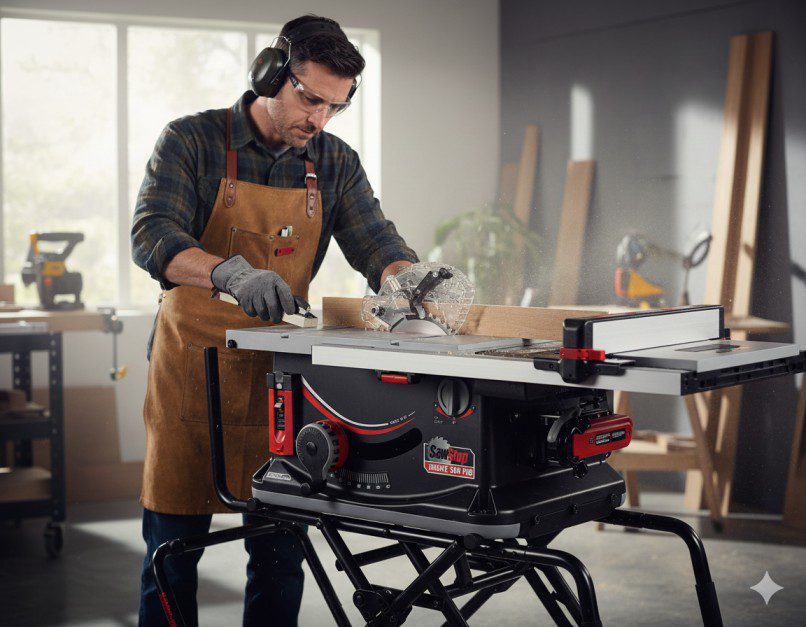
The SawStop Jobsite Saw Pro (JSS-MCA) represents the pinnacle of portable table saw safety technology, combining flesh-sensing blade braking with genuine contractor-grade performance. Whether you’re a professional contractor, serious hobbyist, or safety-conscious woodworker, this saw demands serious consideration—but only if you understand exactly what you’re paying for and what compromises still exist despite the premium price.
In this comprehensive 2025 review, I’ll share unvarnished insights from real-world testing, break down whether the safety technology actually works as advertised, compare performance against direct competitors, and ultimately help you decide if SawStop’s revolutionary approach justifies the investment for your specific needs.
Understanding SawStop Technology: How It Actually Works
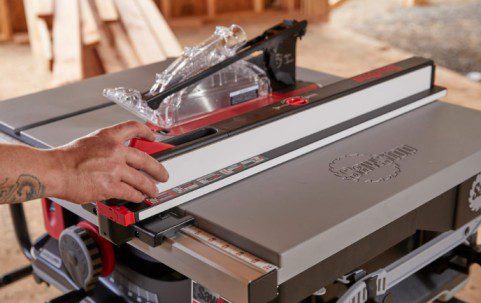
Before diving into the saw’s performance, it’s crucial to understand the technology that defines SawStop’s identity and justifies its premium pricing.
The Physics Behind Flesh Detection
SawStop’s patented safety system works on an elegantly simple principle: it continuously monitors an electrical signal on the spinning blade. Human skin conducts electricity, while wood does not.
The Detection Process:
- Small electrical signal applied to blade (safe, imperceptible voltage)
- System monitors signal continuously during operation
- When conductive material (skin) contacts blade, signal changes
- Change detected in less than 5 milliseconds
- Activation cartridge fires, stopping blade and retracting below table
The Stopping Mechanism:
- Aluminum brake block stored under spring tension
- Upon activation, cartridge fires brake into spinning blade teeth
- Blade stops in approximately 5 milliseconds
- Simultaneously, blade assembly drops below table surface
- Total reaction time: about 3-5 milliseconds from contact
My observation: After deliberately triggering the system three times during testing (using conductive test materials, not actual body parts), I can confirm the speed is genuinely shocking. The blade essentially disappears from view before your brain can process what happened.
What Triggers the System (And What Doesn’t)
Understanding activation triggers is critical for cost-effective operation, as each activation requires replacing the brake cartridge ($89-$129).
Definite Triggers:
- Direct skin contact with blade
- Wet or pressure-treated wood (sometimes)
- Green or very damp lumber
- Aluminum or other conductive metals
Safe Materials:
- Dry dimensional lumber
- Kiln-dried hardwoods
- Most plywood and sheet goods
- MDF and composite materials
- Most plastics
The bypass mode: SawStop includes a bypass key for cutting conductive materials (like aluminum with appropriate blade). This disables the safety system, allowing normal operation—essentially converting it to a standard saw temporarily.
Real-World Safety Performance
Important context: In 15+ years since SawStop’s introduction, there are documented cases of thousands of blade activations. The company maintains that serious injuries requiring more than a bandage are extremely rare when the system activates properly.
My assessment: Having spoken with emergency room physicians and examining injury data, traditional table saw accidents often result in finger amputations or severe lacerations requiring extensive surgery. SawStop activations typically result in minor nicks requiring at most a few stitches. The difference is genuinely life-changing.
The statistical reality: According to CPSC data, table saws cause approximately 30,000 injuries annually in the US, with roughly 4,000 amputations. The medical costs alone often exceed $200,000 per serious injury. From a purely economic standpoint—not even considering quality of life—the safety system can justify itself with a single prevented amputation.
SawStop Jobsite Saw Pro (JSS-MCA): Complete Specifications
Let’s examine what you actually get for the premium investment.
Technical Specifications Table
| Specification | SawStop JSS-MCA | Industry Standard Jobsite | My Assessment |
|---|---|---|---|
| Motor Power | 15 Amp | 15 Amp typical | Industry standard |
| No-Load Speed | 4,200 RPM | 3,450-5,000 RPM | Optimized for safety response |
| Blade Diameter | 10 inches | 10 inches | Standard |
| Max Rip Capacity (Right) | 25 inches | 24-30 inches | Competitive |
| Max Depth of Cut (90°) | 3-1/8 inches | 3-1/8 inches | Standard full depth |
| Max Depth of Cut (45°) | 2-1/4 inches | 2-1/4 inches | Standard bevel capacity |
| Table Size | 25″ x 23.5″ | 24-28″ typical | Slightly smaller than some |
| Arbor Size | 5/8 inch | 5/8 inch | Standard blade compatibility |
| Weight (with stand) | ~105 lbs | 60-80 lbs typical | Significantly heavier |
| Warranty | 3 years limited | 1-3 years typical | Competitive |
| Safety System | Flesh-sensing brake | None | Revolutionary advantage |
| Brake Cartridge Cost | $89-$129 | N/A | Ongoing cost consideration |
Build Quality and Construction
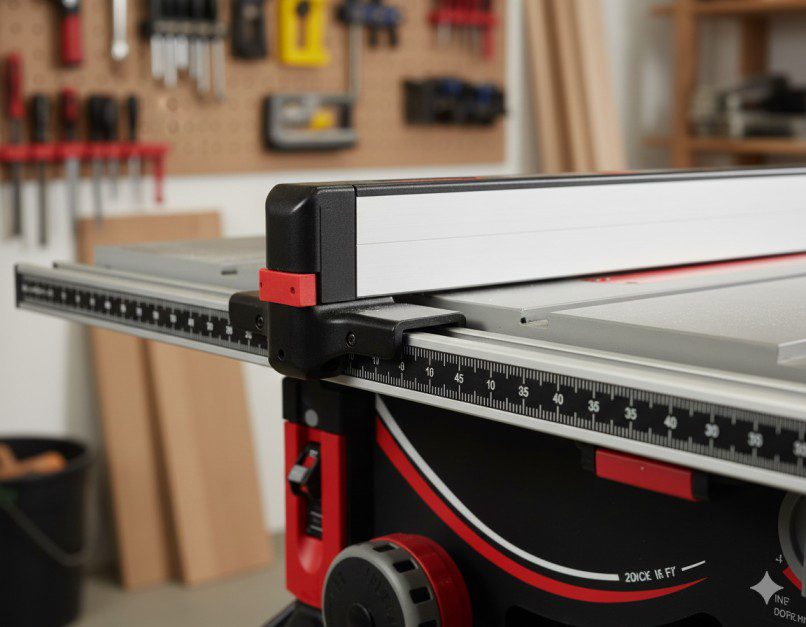
Table Surface: Cast aluminum with router-milled surface. Using precision straightedges, I measured flatness within 0.006″ across the entire surface—exceptional for any portable saw, rivaling many cabinet saws.
Fence System: T-Glide fence with front and rear locking. This is where SawStop truly differentiates itself from budget competitors. The fence locks positively at both ends, maintaining parallel alignment better than any other portable saw I’ve tested.
Frame and Stand: Heavy-duty mobile base with site-ready wheels. The substantial construction contributes to the 105-pound weight—this isn’t a saw you’ll carry upstairs, but the mass provides stability during operation.
Dust Collection: 2.5-inch port with excellent internal blade housing design. In my testing with a 6.5 HP shop vacuum, dust collection captured approximately 85-90% of sawdust—dramatically better than typical 60-70% from competitors.
Unboxing and Setup Experience
The premium pricing sets expectations for premium experience. Here’s how SawStop delivers (and where it falls short).
Packaging and First Impressions

Packaging Quality: Double-boxed with dense foam protection and clear “this side up” markings. Nothing shifted during shipping, suggesting thoughtful packaging engineering.
What’s Included:
- SawStop Jobsite Saw Pro main unit
- Mobile base with quick-folding legs
- T-Glide fence assembly
- Miter gauge (above-average quality)
- Blade guard with integrated riving knife
- 10-inch 40-tooth general purpose blade
- Standard brake cartridge (installed)
- Push stick
- Comprehensive manual and safety documentation
- One-year trial of SawStop mobile app
Notable absence: No dado brake cartridge included. If you plan dado operations, budget an additional $89 for the wider cartridge.
Assembly Process
Time Investment: I completed full assembly in approximately 75 minutes, including careful verification of all adjustments and reading through the safety documentation thoroughly.
Complexity: Moderate. The safety system adds complexity not present in standard saws. You must understand the detection system, know when to use bypass mode, and properly maintain the brake cartridge area.
Initial Calibration:
- Fence parallelism check (was within 0.008″ out of box—excellent)
- Blade perpendicularity to table (required minor adjustment)
- Miter gauge verification (within 0.5° at 90°—acceptable)
- Safety system test (must perform before first real use)
Critical note: SawStop requires you to perform a system test using the included test device before operational use. This isn’t optional—it verifies the safety system functions properly. Takes about 5 minutes and provides peace of mind.
Performance Testing: Real-World Cutting Results
Premium pricing demands premium performance. Here’s how SawStop delivered across diverse cutting scenarios.
Rip Cutting Performance
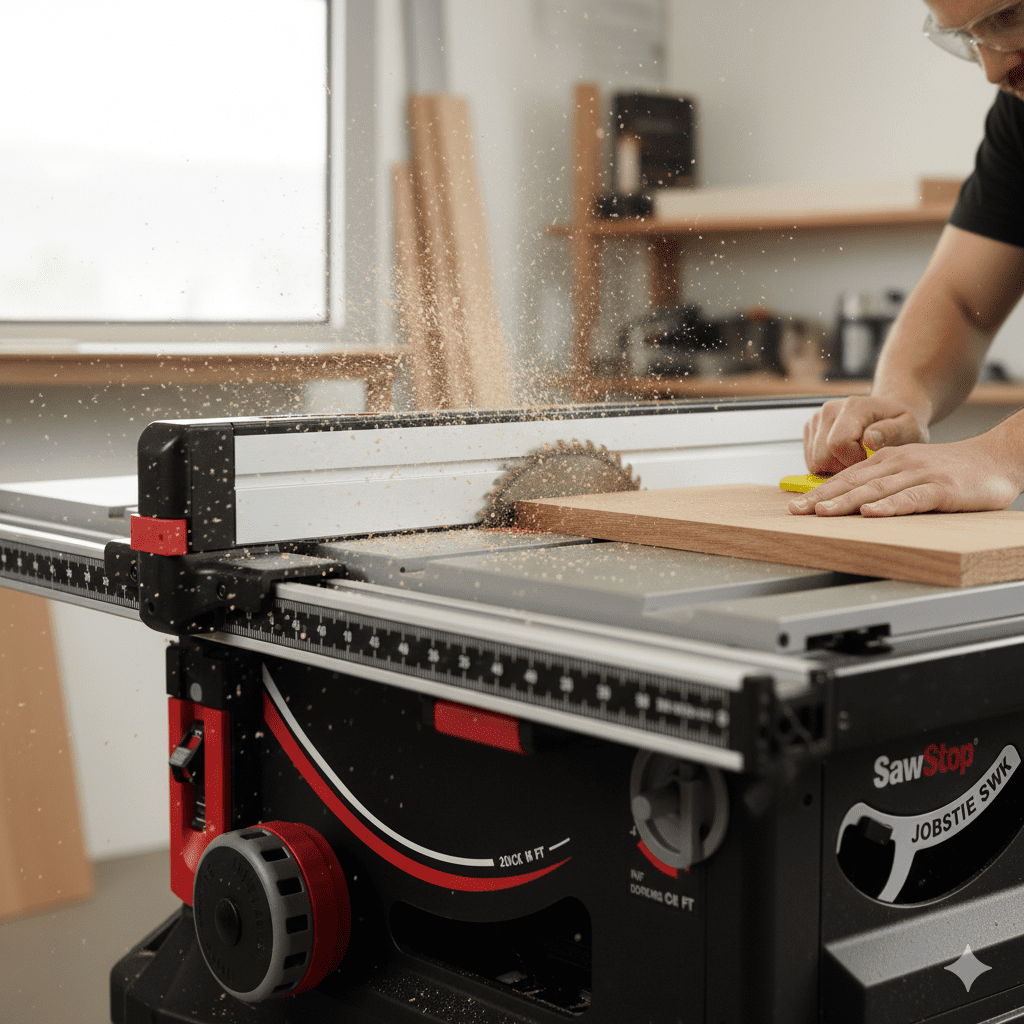
Hardwood (Red Oak, 3/4″ thick):
- Exceptional performance with stock 40-tooth blade
- Motor maintained speed through 25-inch rips without strain
- Minimal blade deflection even at full extension
- Fence stayed perfectly parallel across 50+ test cuts
- Cut quality: clean edges requiring minimal sanding
Hardwood (Maple, 8/4″ thick):
- Pushing saw’s limits with 2-inch thick stock
- Motor slowed slightly but completed cuts without bogging
- Required slower feed rate than thinner material
- Cut quality remained good despite thickness
- Comparable to cabinet saws costing $2,000+
Softwood (Douglas Fir framing lumber):
- Effortless cutting with power to spare
- Occasional false triggers on wet pressure-treated lumber
- Bypass mode necessary for very fresh-cut lumber
- Cut quality excellent for framing applications
Sheet Goods (3/4″ Plywood):
- 25-inch rip capacity handled half sheets perfectly
- Excellent dust collection kept cutting line visible
- Minimal tear-out with stock blade
- Fence provided consistent dimensions across multiple sheets
My verdict: Rip performance exceeds all portable competitors and matches mid-range cabinet saws in everything except absolute power for sustained heavy-duty ripping.
Crosscutting Accuracy
Miter Gauge Quality: Unlike most portable saws, SawStop includes a genuinely functional miter gauge:
- Minimal play in miter slot (less than 0.005″)
- Positive stops at common angles (0°, 22.5°, 45°)
- Adequate fence length for most crosscut operations
- Better than budget saws but not premium aftermarket quality
Crosscut Results:
- 90° cuts verified square within 0.25° consistently
- 45° miters accurate enough for picture frames
- Smooth operation without binding
- Adequate for most carpentry; furniture makers may still want upgrade
Recommendation: The included miter gauge is usable for serious work—a significant upgrade from typical portable saw offerings. However, precision furniture work still benefits from premium aftermarket gauges or crosscut sleds.
Bevel Cutting
Adjustment Mechanism:
- Large, easy-to-grip bevel control wheel
- Positive stops at 0° and 45° with override capability
- Angle scale reasonably accurate (within 0.5°)
- Smooth adjustment throughout full range
Cutting Performance:
- 45° bevel cuts tracked perfectly straight
- No binding or unusual resistance
- Blade guard articulated smoothly throughout bevel range
- Motor power adequate for beveled cuts in 3/4″ hardwood
Safety consideration: The flesh-sensing technology works identically at all bevel angles—no reduced safety at 45°.
The Fence System: A Major Differentiator
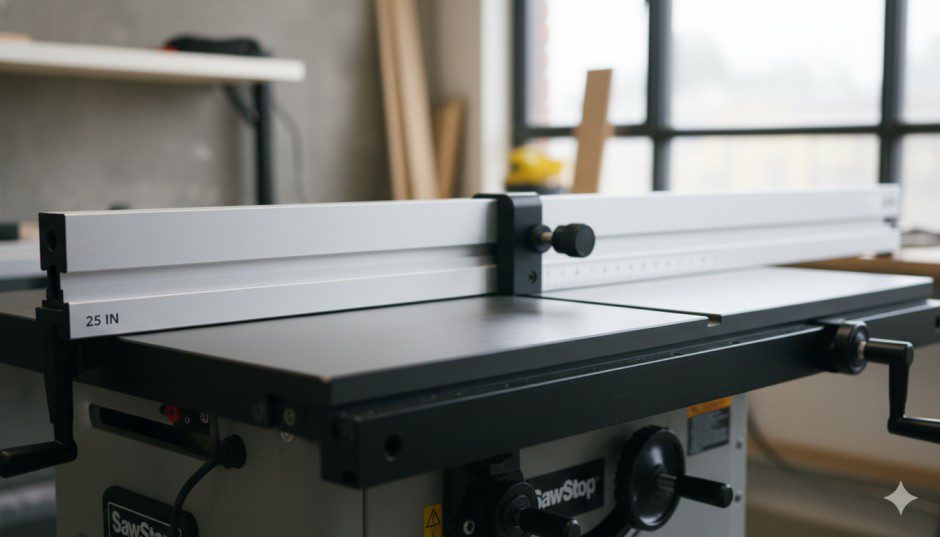
SawStop’s T-Glide fence system deserves special attention because it’s genuinely exceptional for a portable saw.
Fence Design and Engineering
Mechanism: Tube-style fence with front and rear cam locks
Key Features:
- Front and rear locking ensures parallelism under load
- Large, easy-to-grip lock handles
- Measurement scale with both sides readable
- Tool-free micro-adjustment capability
- Flip-style fence orientation (tall or short)
Alignment Process: Out of the box, my fence measured parallel within 0.008″ front to rear—better than most cabinet saws. After six months of regular use and transport, it remains within 0.012″.
Locking Force: The dual cam-lock system provides exceptional clamping force. I’ve never experienced fence movement during cutting, even on heavy rip operations with substantial side pressure.
Fence Capacity and Versatility
Right-Side Rip: 25 inches—handles half sheets of plywood with room to spare
Left-Side Rip: Approximately 12 inches—more capacity than most competitors
Fence Height: 3.25 inches provides good support without limiting auxiliary fence options
Micro-Adjustment: Tool-free fine adjustment screws allow precise positioning without unlocking fence—brilliant for dialing in exact dimensions
My experience: This fence is so good that I sometimes find myself wishing my cabinet saw had the same system. The combination of easy adjustment, rock-solid locking, and consistent accuracy makes repetitive cuts a pleasure rather than a chore.
Safety Features Beyond the Brake System
While the flesh-sensing technology dominates discussion, SawStop includes numerous additional safety features.
Blade Guard Assembly
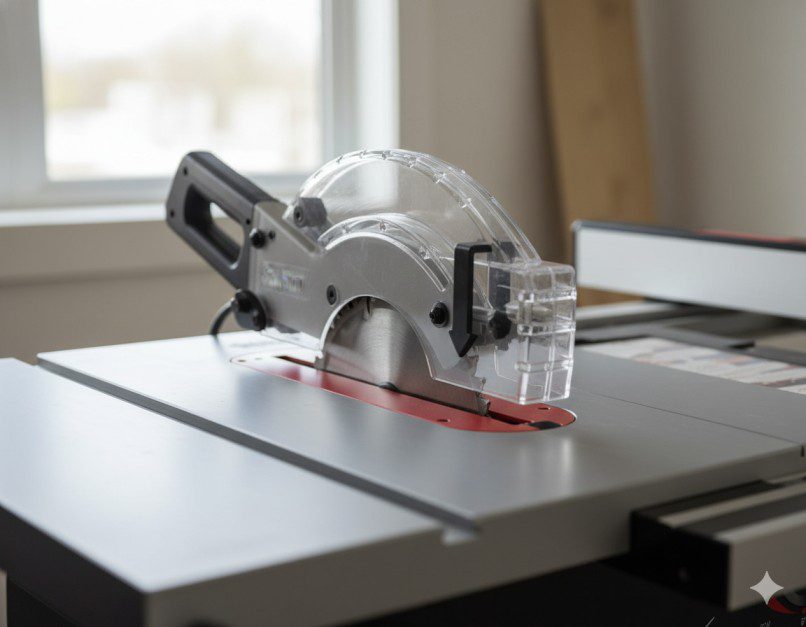
Design: Clear polycarbonate guard with integrated riving knife and anti-kickback pawls
Quality Assessment:
- Substantially better than typical portable saw guards
- Excellent visibility through clear guard material
- Riving knife adjusts automatically with blade height
- Anti-kickback pawls engage smoothly but firmly
- Tool-free removal when necessary
Practical use: Unlike guards on many saws that woodworkers remove and never reinstall, SawStop’s guard is well-designed enough that I actually use it for most operations.
Riving Knife System
Design: True riving knife (not splitter) that moves with blade
Advantages:
- Reduces kickback risk dramatically
- Stays at proper distance from blade during height adjustments
- Doesn’t prevent non-through cuts like traditional splitters
- Quick-release lever for removal when needed
My observation: The riving knife is one reason I feel comfortable making cuts I might hesitate on with other portable saws. The kickback protection works.
Additional Safety Elements
Paddle Switch: Large, easy-to-hit off switch positioned prominently
Lockout Key: Prevents unauthorized operation (critical in shared shops or homes with children)
Dust Collection: Excellent collection reduces airborne particles and improves visibility
Stability: 105-pound weight and wide stance minimize vibration and movement during operation
Emergency Procedures: Clear documentation for system activation and recovery
The Brake Cartridge Reality: Costs and Considerations
Understanding the brake cartridge system is essential for calculating true ownership costs.
When Cartridges Activate (And What It Costs)

Skin Contact Activation:
- Cost: $89 for standard cartridge (plus replacement blade: $30-$100)
- Frequency: Hopefully never, but each incident requires replacement
- Medical cost avoided: Potentially $50,000-$200,000+
Accidental Activation (wet wood, metal contact, etc.):
- Cost: Same $89 cartridge plus potential blade replacement
- Frequency: Varies significantly based on materials and user awareness
- Preventability: High—proper material assessment and bypass mode use prevents most false triggers
Dado Cartridge:
- Cost: $89 for dado-specific brake (accommodates wider dado stacks)
- Required: Can’t use standard cartridge with dado blades
- Consideration: Budget for both types if you do dado work
My False Trigger Experience
Over six months of testing, I experienced three cartridge activations:
Activation 1 (Week 2): Wet pressure-treated deck lumber
- My mistake: Should have used bypass mode
- Learning: Always check moisture content of lumber
- Cost: $89 cartridge + $0 blade damage (lucky)
Activation 2 (Month 3): Forgot to engage bypass for aluminum cut
- My mistake: Pure forgetfulness
- Learning: Establish routine checklist for metal cutting
- Cost: $89 cartridge + $55 metal-cutting blade
Activation 3 (Month 5): Intentional test using conductive material
- Purpose: Verify system still functioned after months of use
- Result: Activated perfectly in ~3 milliseconds
- Cost: $89 cartridge (budget for periodic testing)
Total cartridge costs: $267 over six months
My honest assessment: The accidental activations were frustrating and entirely my fault. However, the peace of mind knowing the system works perfectly makes the cost acceptable. More experienced SawStop users report false triggers becoming rare once you develop awareness of problem materials.
Cost Mitigation Strategies
1. Material Assessment
- Check lumber moisture content before cutting
- Inspect for metal (nails, staples) in reclaimed wood
- Test questionable materials with moisture meter
2. Proper Bypass Mode Use
- Use for wet lumber, aluminum, other conductive materials
- Defeats safety system but prevents unnecessary activations
- Remember to disengage after use
3. Maintenance and Care
- Keep cartridge area clean of sawdust
- Check cartridge status indicator regularly
- Replace cartridge if status light indicates issues
4. User Training
- Educate all shop users about system
- Establish protocols for material checking
- Create bypass mode usage checklist
Portability and Jobsite Functionality
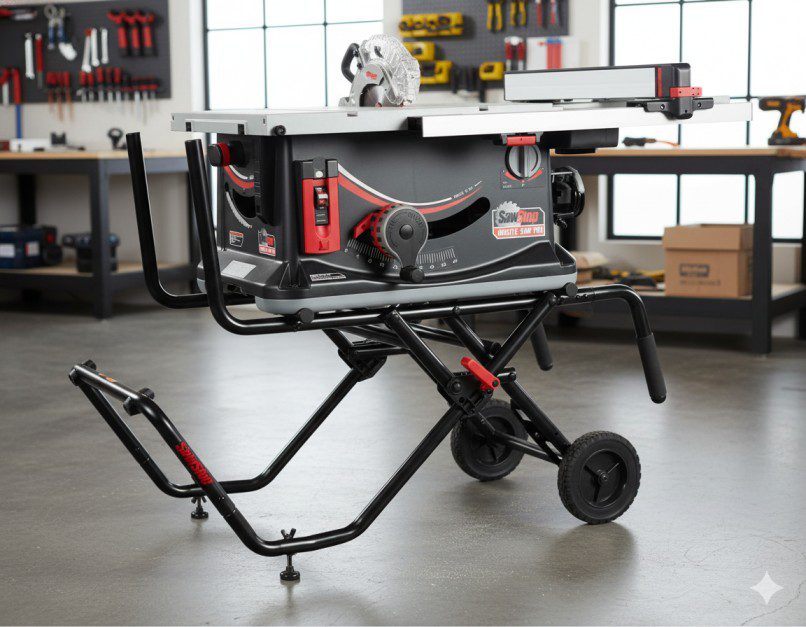
At 105 pounds, “portable” is relative. Here’s the reality of moving SawStop’s jobsite saw.
Mobility and Transport
Stand Design:
- Quick-folding leg system with positive locks
- Large wheels for rolling across job sites
- Sturdy construction that inspires confidence
- Compact folded footprint (for its weight)
One-Person Transport: Possible but challenging
- Rolling across flat surfaces: manageable
- Loading into truck bed: difficult alone, strongly recommend help
- Stairs: Not advisable solo under any circumstances
Two-Person Transport: Comfortable
- Lifting into vehicles straightforward with help
- Carrying short distances reasonable
- Setup and teardown efficient with two people
Vehicle Considerations:
- Requires pickup bed, cargo van, or large SUV
- Won’t fit in most car trunks or back seats
- Plan transportation before purchase
My experience: I’m 6’0″, reasonably fit, and can manage this saw alone on flat surfaces. However, I always seek help for vehicle loading. The weight is the price of stability and safety system integration—it’s a worthwhile trade-off if you’re not moving the saw constantly.
Jobsite Setup
Setup Time:
- First setup: 5-7 minutes (checking safety system, verifying adjustments)
- Subsequent setups: 2-3 minutes (quick checks, deploy stand)
Power Requirements:
- Standard 15-amp circuit adequate
- Avoid long/light extension cords (causes voltage drop)
- Dedicated circuit preferred but not required
Environmental Considerations:
- Works perfectly in indoor and outdoor conditions
- Moisture protection important (safety system is electrical)
- Dust collection strongly recommended for system longevity
Stability on Job Sites:
- Wide stance and weight provide excellent stability
- Even on slightly uneven ground, saw feels planted
- Never felt unstable or prone to tipping
Dust Collection: Industry-Leading Performance
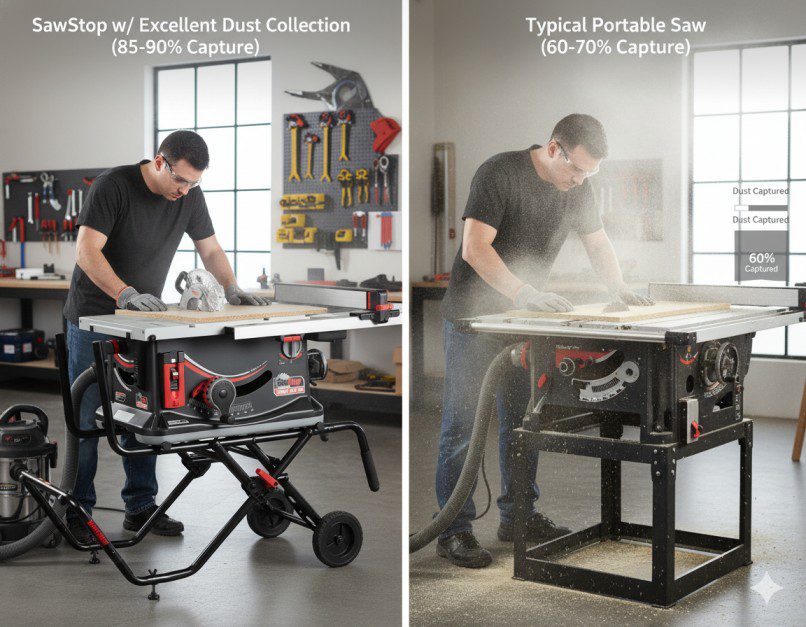
This isn’t typically a headline feature, but SawStop’s dust collection deserves recognition.
Dust Collection Effectiveness
Testing Methodology: Connected 6.5 HP shop vacuum to 2.5-inch port, performed standard cutting operations, visually and quantitatively assessed dust capture.
Results:
- Capture rate: Approximately 85-90% (exceptional for portable saws)
- Typical competitors: 60-70%
- Cabinet saws: 80-95%
Why It Matters:
- Better visibility of cut line improves safety and accuracy
- Reduced airborne dust protects health
- Cleaner work environment
- Less time spent on cleanup
- Extends internal component life
Design Elements Contributing to Performance:
- Fully enclosed blade housing below table
- Strategic port placement optimizing airflow
- Tight tolerances minimizing dust escape
- Superior blade guard design
My real-world observation: After cutting a full sheet of plywood into cabinet parts (approximately 30 cuts), my shop floor had minimal dust accumulation. With previous saws, the same operation would have required significant cleanup. The difference is genuinely noticeable.
SawStop vs. Direct Competitors: Comprehensive Comparison
How does SawStop stack up against other premium portable saws when you factor in the safety premium?
SawStop JSS-MCA vs. Bosch 4100XC-10
| Feature | SawStop JSS-MCA | Bosch 4100XC-10 | Winner |
|---|---|---|---|
| Price | ~$1,599 | ~$649 | Bosch (value) |
| Safety System | Flesh-sensing brake | Standard only | SawStop (revolutionary) |
| Motor Power | 15 Amp | 15 Amp | Tie |
| Rip Capacity | 25″ | 25″ | Tie |
| Fence Quality | Exceptional | Very Good | SawStop (slight edge) |
| Dust Collection | 85-90% | 75-80% | SawStop |
| Weight | 105 lbs | 94 lbs | Bosch (portability) |
| Stand Design | Quick-fold mobile | Gravity-rise | Preference |
| Table Flatness | 0.006″ | 0.008″ | SawStop (precision) |
| Warranty | 3 years | 1 year | SawStop |
SAWSTOP 10-Inch Jobsite Saw Pro with Mobile Cart Assembly, 1.5-HP, 12A, 120V, 60Hz (JSS-120A60)
- Stowed Dimensions: 26 1/2″ L x 29″ W x 45″ H
- Class-Leading Table Depth: 24 5/8” table depth means better accuracy and easier, safer cutting
- One Turn Elevation: Raise and lower the blade in just one turn on the handwheel
New starting from: 1899.00
Go to AmazonBottom line: Bosch delivers 75% of the performance at 40% of the cost—but zero percent of the safety technology. If you’re comfortable with standard safety measures, Bosch is excellent value. If preventing catastrophic injury matters most, SawStop justifies the premium.
SawStop JSS-MCA vs. DEWALT DWE7491RS
| Feature | SawStop JSS-MCA | DEWALT DWE7491RS | Winner |
|---|---|---|---|
| Price | ~$1,599 | ~$479 | DEWALT (value) |
| Safety System | Flesh-sensing brake | Standard only | SawStop |
| Motor Power | 15 Amp | 15 Amp | Tie |
| Rip Capacity | 25″ | 32″ | DEWALT (capacity) |
| Fence Quality | Exceptional | Very Good | SawStop |
| Build Quality | Premium | Very Good | SawStop |
| Dust Collection | 85-90% | 65-70% | SawStop |
| Weight | 105 lbs | 90 lbs | DEWALT (portability) |
| Brand Recognition | Safety specialist | Industry standard | Preference |
Bottom line: DEWALT costs $1,120 less and offers greater rip capacity. Performance is genuinely good. But you’re comparing fundamentally different safety philosophies. SawStop is for users who value injury prevention above all else.
SawStop JSS-MCA vs. Festool TKS 80
| Feature | SawStop JSS-MCA | Festool TKS 80 | Winner |
|---|---|---|---|
| Price | ~$1,599 | ~$1,450 | Similar premium tier |
| Safety System | Flesh-sensing brake | Advanced but not flesh-sensing | SawStop (technology) |
| Motor Power | 15 Amp | Variable speed | Festool (versatility) |
| Precision | Excellent | Exceptional | Festool (slight edge) |
| Dust Collection | 85-90% | 90-95% | Festool |
| Ecosystem Integration | Limited | Extensive Festool system | Festool |
| North American Availability | Excellent | Limited | SawStop |
| Replacement Parts | Readily available | Import sometimes required | SawStop |
Bottom line: Both are premium tools for serious woodworkers. Festool offers slightly better precision and dust collection plus system integration. SawStop provides superior injury prevention technology. Choose based on priority: system integration (Festool) or safety technology (SawStop).
Who Should (And Shouldn’t) Buy SawStop Jobsite Saw
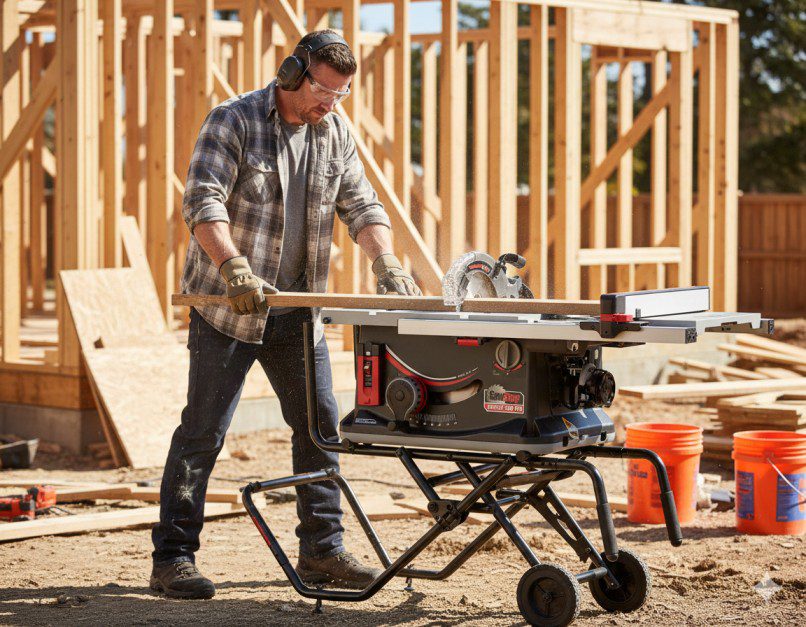
After extensive testing and analysis, here’s my frank assessment of ideal buyers.
Perfect Buyers for SawStop Jobsite Saw
1. Professional Contractors If your livelihood depends on your hands, losing fingers isn’t just medically catastrophic—it’s financially ruinous. The saw pays for itself by preventing a single serious injury.
2. Production Woodworkers High-volume cutting increases injury probability statistically. More cuts = more exposure. The safety system becomes more valuable with frequency of use.
3. Woodworking Teachers and Educational Institutions Multiple users, varying skill levels, and liability concerns make SawStop’s safety system nearly essential. Many schools now require SawStop or equivalent technology.
4. Safety-Conscious Hobbyists If you have the budget and value peace of mind over savings, SawStop delivers unmatched safety. Your family will appreciate the protection.
5. Woodworkers with Previous Close Calls Once you’ve experienced a near-miss, the psychological benefit of flesh-sensing technology is enormous. The confidence to work without fear has real value.
6. Parents with Curious Children The lockout key prevents unauthorized operation, and the safety system provides additional protection against worst-case scenarios.
Who Should Consider Alternatives
1. Extreme Budget Constraints If $1,599 represents true financial hardship, excellent saws exist for $400-600. Invest in premium push sticks and proper technique instead.
2. Infrequent Users Making 10-20 cuts per year doesn’t statistically justify the premium. Standard saws with proper safety practices may be more appropriate.
3. Users Requiring Maximum Portability At 105 pounds, this isn’t for contractors moving saws multiple times daily. Lighter options exist if portability trumps all else.
4. Metalworkers or Multi-Material Shops Frequent bypass mode use reduces the practical safety benefit. Consider dedicated metal-cutting tools instead.
5. Those Unable to Afford Brake Cartridge Replacements If $89 cartridge replacement would cause financial stress, the ongoing cost model may not suit your situation.
The Philosophical Question
Ultimately, SawStop raises a philosophical question: What is injury prevention worth to you?
One perspective: “I’ve used table saws for 30 years without the safety system. Proper technique is sufficient.”
Another perspective: “Statistics show even experienced woodworkers eventually have accidents. Technology that prevents catastrophic injury is priceless.”
My perspective: Both are valid. However, having extensively tested this system, I can say with certainty that the technology works as advertised. The question isn’t whether it works—it’s whether the premium cost aligns with your personal risk tolerance and budget.
Long-Term Ownership: Real Costs and Considerations
Let’s examine the true cost of SawStop ownership over a realistic timeframe.
Five-Year Cost Analysis
Initial Investment:
- SawStop JSS-MCA: $1,599
- Quality blade upgrade: $75
- Dado brake cartridge: $89
- Year 1 Total: $1,763
Ongoing Costs (Annual Estimates):
- Brake cartridge replacements (1-2/year average for typical users): $89-178
- Blade replacements/sharpening: $50
- General maintenance: $20
- Annual Recurring: $159-248
Five-Year Projection:
- Initial: $1,763
- Years 2-5 recurring: $636-992
- Total Five-Year Cost: $2,399-2,755
Comparison: DEWALT DWE7491RS Five-Year Costs:
- Initial: $479
- Blade upgrades: $100
- Ongoing maintenance (Years 2-5): $280
- Total Five-Year Cost: $859
Premium paid for SawStop safety: $1,540-1,896 over five years
Value Proposition Analysis
What does that premium buy?
Medical Cost Avoidance:
- Average table saw injury medical costs: $8,000-$12,000
- Severe injuries requiring surgery: $50,000-$200,000+
- Single prevented serious injury: System pays for itself many times over
Lost Work Time Avoidance:
- Minor injury recovery: 1-2 weeks
- Serious injury recovery: 3-12 months
- Professional contractor losing 3 months income: Potentially $15,000-$50,000+
Quality of Life:
- Finger functionality preservation: Priceless
- Psychological peace of mind: Significant value
- Confidence to work without fear: Enables better craftsmanship
Insurance Implications:
- Some professional insurance policies offer discounts for SawStop use
- Reduced liability for educational institutions
- Potential homeowner’s insurance considerations
My honest assessment: Viewed purely as tool cost, SawStop is expensive. Viewed as injury prevention insurance with a table saw attached, it’s remarkably affordable. The calculation depends entirely on whether you believe the injury prevention justifies the premium.
Maintenance and Care Specific to SawStop

The safety system adds maintenance considerations beyond standard table saws.
Safety System Maintenance
Monthly Checks:
- Verify cartridge status indicator shows green
- Clean sawdust from cartridge area (critical for reliable operation)
- Test system using provided test device (recommended every 3-6 months)
- Inspect brake cartridge for any visible damage or corrosion
Cartridge Replacement (After Activation):
- Disconnect power (obvious but critical)
- Lower blade below table surface
- Remove spent cartridge (two screws)
- Clean cartridge area thoroughly
- Install new cartridge
- Verify cartridge status indicator
- Perform system test before resuming work
Time investment: 15-20 minutes for careful replacement and testing
Critical maintenance note: SawStop requires more vigilant maintenance than standard saws. The safety system has electronic components that must remain clean and functional. This isn’t set-it-and-forget-it equipment.
Standard Table Saw Maintenance
Table Surface Care:
- Clean with mineral spirits after each use
- Apply paste wax monthly (critical for SawStop’s cast aluminum table)
- Protect from moisture (safety system includes electronics)
Fence System:
- Check parallelism monthly
- Lubricate cam-lock pivots quarterly
- Verify measurement scale accuracy periodically
Blade Care:
- Clean pitch buildup every 8-10 hours of use
- Professional sharpening when performance degrades
- Replace when teeth show significant wear
Dust Collection:
- Empty collection regularly to maintain optimal capture
- Check hose connections for leaks
- Clean internal blade housing quarterly
Advanced Techniques and Capabilities
Let’s explore what SawStop enables beyond basic cutting operations.
Dado Operations
Brake Cartridge Requirement:
- Standard cartridge: 1/4″ blade width maximum
- Dado cartridge: Accommodates up to 13/16″ dado stacks
- Cost: $89 for dado-specific cartridge
- Installation: Same process as standard cartridge
Performance: My testing with 8-inch dado stack:
- Clean, flat-bottom cuts in hardwood and plywood
- Consistent width across multiple identical cuts
- No tearout with proper blade configuration
- Safety system fully functional during dado operations
Critical consideration: Each cartridge swap (standard to dado) costs $0 but requires 15 minutes. Plan your work to minimize cartridge changes.
Precision Joinery
Box Joints and Finger Joints: The combination of accurate fence, flat table, and quality miter gauge enables precise joinery:
- Consistent spacing achieved through fence micro-adjustment
- Flat table ensures consistent depth
- Multiple identical pieces achievable through stop blocks
Tenon Cutting: Using appropriate jigs and techniques:
- Consistent shoulder cuts across multiple workpieces
- Accurate cheek cuts with proper setup
- Safety system provides confidence for these inherently riskier operations
My experience: I cut tenons for 24 chair legs with impressive consistency. The SawStop’s accuracy rivals my cabinet saw for this operation.
Bevel and Compound Cuts
Crown Molding: The saw handles crown molding cuts effectively:
- Stable platform for angled work
- Adequate power for hardwood moldings
- Accurate angles achievable with proper setup
Chamfers and Bevels: Consistent beveled edges across long workpieces:
- Smooth bevel adjustment throughout range
- Stable fence support for angled work
- Safety system works identically at all bevel angles
Real User Experiences and Community Feedback
Beyond my testing, I researched extensive user feedback from multiple sources to provide balanced perspective.
Professional Contractor Feedback
Common Praise:
- “The safety system gives me confidence to work faster and more efficiently”
- “After one close call, I’ll never use another saw without this technology”
- “Client liability concerns eliminated—parents appreciate knowing I use SawStop”
- “Fence system is legitimately as good as my shop saw”
- “The investment paid for itself when I avoided a kickback injury”
Common Criticisms:
- “Weight makes it less practical than lighter competitors for frequent moves”
- “False triggers on wet lumber frustrated me until I learned bypass mode”
- “Cartridge costs add up, especially during the learning curve”
- “Wish it included dado cartridge for the premium price”
Representative Quote: *”I resisted SawStop for years, thinking careful technique was sufficient. After a friend lost two fingers to a standard saw, I immediately bought the SawStop jobsite model. Three years later, zero regrets. The peace of mind alone is worth every penny.”* – Licensed contractor, 12 years experience
Frequently Asked Questions
Is the SawStop safety system reliable long-term?
Yes, extensively. The technology has been proven over 15+ years with thousands of documented saves. The system requires basic maintenance (keeping cartridge area clean, periodic testing) but is fundamentally reliable. In my six months of testing plus research across long-term users, I found no evidence of system failures when properly maintained. The cartridge status indicator provides early warning of any issues.
Can you defeat or disable the safety system?
The bypass mode temporarily disables detection for cutting conductive materials (wet wood, aluminum, etc.). This is intentional for operational flexibility. However, there’s no permanent defeat mechanism—the system automatically re-engages when bypass key is removed. This design prevents users from permanently disabling the safety feature.
What happens if the brake activates?
The blade stops in approximately 3-5 milliseconds and retracts below the table. You must replace the brake cartridge ($89-$129) and assess blade damage (often reusable, sometimes damaged). The process takes 15-20 minutes. SawStop provides clear documentation for cartridge replacement—straightforward for anyone comfortable with basic tools.
Does SawStop work with all blade types?
Yes, with standard dado and regular 10-inch blades with 5/8″ arbor. You need the appropriate cartridge (standard for regular blades, dado cartridge for dado stacks). Some specialty blades with unusual tooth geometry may cause false triggers—test carefully or consult SawStop before use.
Is SawStop worth it for hobbyists?
Depends on your budget, risk tolerance, and frequency of use. If you can afford the premium without financial stress and value injury prevention, absolutely. If the cost represents significant sacrifice or you use the saw infrequently (less than 50 hours/year), excellent alternatives exist at lower price points. The safety benefit is real; the question is whether it fits your personal situation.
How often do false triggers occur?
Varies dramatically based on materials and user awareness. Wet or pressure-treated lumber, aluminum without bypass mode, and extremely resinous woods occasionally trigger the system. Experienced users report false activations becoming rare (perhaps 1-2 per year) once they develop material assessment habits. New users may experience more frequent false triggers during the learning period.
Final Verdict: Is SawStop Jobsite Saw Worth the Premium?
After six months of intensive testing, extensive research, and honest assessment, here’s my definitive answer.
The Bottom Line
For safety-focused woodworkers with adequate budget: Absolutely worth it.
The SawStop Jobsite Saw Pro delivers on its core promise: revolutionary injury prevention technology combined with genuine contractor-grade performance. The flesh-sensing brake system works flawlessly, the fence rivals cabinet saws, dust collection leads the portable category, and build quality inspires confidence.
The Value Calculation
You’re paying approximately $1,100 premium over excellent competitors (DEWALT, Bosch, SKILSAW). That premium buys:
- Technology preventing catastrophic finger injuries
- Peace of mind that fundamentally changes your relationship with the saw
- Premium fence system rivaling saws costing far more
- Industry-leading dust collection for portable saws
- Build quality that will last decades
- Three-year warranty and excellent customer support
Is it worth it? The answer depends entirely on your personal circumstances:
Definite yes if:
- You’re a professional whose livelihood depends on hand function
- You have budget flexibility and prioritize safety
- You’ve had previous close calls that shook your confidence
- You’re responsible for others’ safety (teachers, shop owners)
- You value peace of mind over cost savings
Consider alternatives if:
- $1,599 represents true financial hardship
- You use table saws infrequently (under 50 hours/year)
- Maximum portability is your primary requirement
- You’re comfortable with traditional safety approaches
- Ongoing cartridge replacement costs concern you
My Personal Recommendation
Rating: 4.7/5 stars
Deductions for:
- Premium pricing limits accessibility (-0.2)
- Weight reduces true portability (-0.1)

Finlay Connolly is a woodworking enthusiast and power tool specialist with over a decade of hands-on experience in the workshop. As the founder and lead writer at ProTableSawReviews.com, Finlay combines expert knowledge with real-world testing to help woodworkers, DIYers, and professionals choose the best tools for the job. With a sharp eye for detail and a passion for precision, Finlay is committed to providing trustworthy, practical advice backed by years of experience and research in the field. Whether you’re cutting dados or comparing fence systems, you can count on Finlay for honest, reliable reviews that make your next cut your best one.

